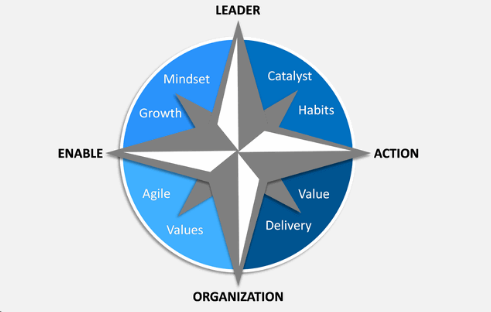Level 5 leadership is a term that was first coined by Good to Great author Jim Collins, a renowned researcher and thought leader in the field of leadership. Level 5 leaders are those exhibiting the very best traits of leadership. Since Level 5 leaders have an especially large impact on a company’s success, every leader should strive to be one.
Table of Contents
What Exactly Is Level 5 Leadership?
ambitious, energizing, driven, frequently exhausting, and utterly unrelenting. Level 5 leadership is all this, yes, but there’s an ‘X factor’ quality that sets it apart from level 4, 3, 2, and level 1 leaders. It’s humility.
“Humility combined with a ferocious will” is how Definition of Level 5 Leadership by Jim Collins. Nothing could be further from the truth than this definition, which makes a Level 5 leader sound like any highly competent person (or impact player).
“The ego-driven Level 4 leaders – they’re really good at inspiring people to follow them,” he told the 2015 World Leadership Summit. “The Level 5 leaders inspire people to follow a cause, and therein is all the difference.”
Jim says Level 5 leaders can be developed, but the quality of their leadership is “far more than simply the sum of its parts.”
“They are a study in contrasts—modest and obstinate, timid and fearless. They lead in a spirit of service, putting the needs of their team and company first,” he says of Level 5 leaders.

What Characteristics Are Present In Level 5 Leaders?
Jim Collins identified 5 characteristics of Level 5 leaders:
1. A personal sense of humility
2. A deep personal understanding of one’s strengths and weaknesses
3. A laser-like focus on the organization’s purpose
4. A passionate commitment to continuous learning
5. A relentless determination to do what is right, not what is easy
How To Develop Level 5 Leaders
The foundations of Level 5 leadership will be clear to you by the end of this blog. Attendees at a world-first Good to Great event were taken through the Level 5 leadership concept with Jim Collins himself outlining the type of leadership essential for taking a company from good to great. Jim’s global bestseller Why Some Businesses Take the Step from Good to Great… and Others Don’t is one of the most cited and successful management books of all time.
A Snapshot Of A Level 5 Leader
An individual who demonstrates both strong personal humility and professional will is considered to be a Level 5 leader. With a strong sense of self-awareness and the ability to prioritize the needs of others over their own, this top-level leader is extremely driven and ambitious.
Level 5 leaders stand out from even competent and effective leaders due to this crucial combination of traits, which we’ll explain below. Even though Level 5 leadership is frequently associated with the business world, this kind of leader can make any organization successful, from nonprofits to governmental organizations.
Level 5 Leaders More Important Than Ever
Additionally, in the quickly evolving, post-pandemic world of today, Level 5 leadership is particularly crucial. Level 5 leaders are the ones who can offer stability and direction in a time when so many things are uncertain. Whether there is a crisis or not, effective leadership ensures that organizational objectives are carried out in accordance with a vision and mission. Finding a Level 5 leader (or acquiring these qualities yourself) is imperative if you want to advance your outcomes.
What Distinguishes Level 5 Leadership As A Concept?
The Jim Collins Level 5 leadership concept is unique because it is backed by sound empirical evidence from a 5-year research project, which debunked the conventional wisdom that only a larger-than-life charismatic leader could lead a company to greatness.
The research was done in 1996 by Jim Collins and his team, and the findings were ground-breaking. Of 1435 established companies studied, only 11 were shown to have made a leap equivalent to a school high jumper clearing a pole vaulting bar used in competition. In other words, they improved from receiving good (no-better-than-average) results to receiving outstanding results.
In financial terms, they had to “generate cumulative stock returns that exceeded the general stock market by at least three times over 15 years—and it had to be a leap independent of its industry.” Each had accomplished a gold medal in the Olympics, if not an Olympic record. One surprise revealed by the research was this Level 5-type leader was at the helm of every one of the 11 good-to-great companies.
Which 5 Levels Of Leadership Are There?
Level 5 leadership is the summit for leaders, and it sits atop a hierarchy of leadership comprising a “base camp” 1st level and three additional levels.
As well as their own unique traits, Level 5 leaders share the qualities of leaders further down the hierarchy (ie. The Level 1, Level 2, Level 3, and Level 4 leaders. Look at these, shall we?
Level 1 Leader: Highly Capable Individual
Impact Players are people of exceptional ability, according to Thinkers 50 thought leader and keynote speaker Liz Wiseman. They are priceless as a person. According to Jim Collins, this first level of leadership is about having good individual skills. The talents, skills, knowledge, and good work habits that make Level 1 leaders productive contributors are listed among their qualities. They effectively contribute to the team and are well aware of the task at hand. They are efficient with their use of knowledge and do a good job.
Level 2 Leader: Contributing Team Member
A Level 2 leader’s primary competency is team building. In order to benefit the team and accomplish team goals, they make use of their strengths as workers. They know how to help the team succeed and they complete jobs effectively, successfully, and productively. They assist others in forming cohesive teams by utilizing their expertise. Impact players can advance to Level 3 or higher from Level 2, where they are also found.
Level 3 Leader: Competent Manager
This hard-working impact player and team stalwart have excellent management skills. Together with their team, they pursue organizational objectives effectively and efficiently. A Level 3 leader is valuable because most organizations are motivated to accomplish their goals and objectives.
Level 4 Leader: Effective Leader
According to Jim Collins, this Level 4 Leader is great at stimulating higher performance standards from their people. Although they aren’t at Level 5, they are effective managers who can inspire their organizations to achieve their goals. In addition to assisting teams in achieving the objectives that give life to the vision, they catalyze commitment to a strong and compelling vision.
Level 5 Leader: Great Leader
As we said earlier, Jim Collins found that the skills of levels 1 to 4 were present in Level 5 leaders, but these great leaders also had an “extra dimension”: a paradoxical blend of personal humility (“I never stopped trying to become qualified for the job”) and professional will (Kimberley Clark former CEO Darwin Smith’s decision to “sell the mills” – see story below).
These Level 5 leadership characteristics are essential for the success of a company because, as Jim Collins says, they motivate the enterprise with “inspired standards” more than an “inspiring personality.”
The Level 5 leader has, Jim Collins says, an “almost stoic determination to do whatever needs to be done to make the company great.”
They are lifelong learners, and passionately so. With a relentless determination to do what is right, they go after results with a laser-like focus on the purpose of the organization.

How Do You Become A Great Leader?
Great leaders use their smarts and ambition not to advance themselves, but to inspire people to follow a cause. This subtle difference is the key to Level 5 (“great”) leadership. Great leaders are highly ambitious for the success of their company and can communicate this to others.
CEO Darwin Smith is a name that not many people are familiar with. Yet Jim Collins describes him as ‘one of the greatest CEOs of the twentieth century. This Level 5 leader oversaw Kimberly-Clark during the contentious sale of its paper mills (the bulk of its business) in order to focus on the consumer goods industry (by acquiring Huggies and Kleenex). Under the shy and self-effacing Darwin Smith, Kimberly-Clark became the number one paper-based consumer products company in the world.
Darwin Smith did not have charisma, rather he had connectional intelligence. Great leaders have this in abundance say Get Big Things Done authors both Saj Nicole and Erica Dhawan. They describe it as “the ability to combine knowledge, ambition, and human capital, forging connections on a global scale that create unprecedented value and meaning”. Smith was a superb leader who persuaded people to support a cause. Great leaders can be distinguished from Level 4 leaders by having connectional intelligence because they have a broader focus.
Level 4 Vs. Level 5
So how does one advance to Level 5 from Level 4? As previously mentioned, it’s not easy to achieve Level 5 leadership status; it takes a special blend of professional will and personal humility.
Professional will means:
- Doing what must be done, no matter how difficult
- Giving credit for your company’s success to others, to external factors, and to good luck, instead of your own actions
- Generating excellence in a company’s outcomes
- Taking actions to ensure the company will endure beyond your tenure
Personal humility means:
- Never being boastful or welcoming of public praise
- Working with calm determination
- Emphasizing a standard of excellence over your ability to inspire through charisma
- Using your personal ambition to make the company greater, rather than making yourself successful
- Looking to yourself when things go wrong instead of to others, external factors, or bad luck
What level 4 and level 5 leaders decide to do with their talents and ambitions defines them. While Level 4 leaders may lead prosperous businesses, they frequently do so in an egotistical, self-fulfilling manner. On the other hand, Level 5 leaders manage their organizations with a spirit of service. While one fails to set up the business for success after his or her departure, the other does so with great care.
In spite of the difficulty, there are benefits to reaching Level 5 leadership. The best compensation for people who advance to Level 5 leadership in their careers is perhaps the legacy of extraordinary influence they leave behind on their companies.
Humility & Professional Will
A-players who deliver results while maintaining humility are essential for the success of your team. This combination of humility and professionalism will keep the team united and working towards the same goal – the success of the company.
Team members who understand the importance of avoiding arrogance are more likely to behave humbly and give credit where credit is due (team bonding and cohesion), admit to mistakes (team vulnerability and trust), work with calm determination (team productivity), and taking action on what needs to be done, no matter the difficulty (team problem-solving).
If we go back to Darwin Smith for a moment, it’s admirable how humble and professional this outstanding CEO was. According to Jim, when Darwin Smith described his time at Kimberly-Clark, he said he had “never stopped trying to become qualified for the job”. Darwin tried to focus on his business and his employees rather than himself, despite abundant evidence of extraordinary success.
Taking Responsibility
From the moment we can walk and talk, our parents try to get us to learn to take responsibility: “Say sorry”, “Don’t take all the biscuits”, “Did you break the window?”. These lessons teach us to smoothly enter and move through society, and they become highly important if we want to become leaders and managers. The Level 5 leader should be the one to look in the mirror rather than “out the window” when the team or organization posts poor results. Immediately they take responsibility and never blame bad luck, other people, or external factors.
Jim Collins asserts that Level 5 leader changes their focus when there are victories. Now they are looking out the window, ready to credit other people for the success, external factors, and good luck!
Key takeaway: Accept responsibility when something goes wrong. Give credit to others when things are going well.
Ask for Help
Your company may be saved by seeking assistance. Novartis Professor of Leadership and Management at Harvard Business School Amy Edmondson says if your people don’t feel safe to speak up, you may create an illusion of success that will turn to bite you later.
“Early information about shortcomings can nearly always mitigate the size and impact of future, large-scale failure,” she writes in her bestseller The Fearless Organization – read our interview with Prof. Edmondson.
A great company will have at its helm a leader who models and encourages employees at all levels to put their hands up and ask for help. This prevents people from lying or faking in their jobs. It also emphasizes those who prioritize the success of the company. Calling upon the expertise of others is not a sign of weakness, rather it’s a sign that this team member is working towards a common goal for the common good. When asking for help is acknowledged and encouraged, the entire team wins.
Key takeaway: Admit your own mistakes, and when others do so and ask for assistance, congratulate them for coming forward.
Discipline
Discipline is a crucial leadership quality of Level 5 leaders. In fact, disciplined people, disciplined thought, and disciplined action are 3 key stages for Jim Collins’ ideas for creating a successful organization that endures. In Level 5 leaders he sees discipline as ‘demonstrating an unwavering resolve to do whatever must be done to produce the best long-term results, no matter how difficult.
His famed concept of the 20-mile-march set out in his book Great by Choice helps to illustrate this unwavering resolve. Two teams competed in 1911 to be the first to the South Pole. One leader Roald Amundsen insisted his team stick to the discipline of a 20-mile march daily, no matter what. The other leader Robert Falcon Scott pushed his team to trek greater distances in better weather, and rest when conditions were poor. Team Amundsen prevailed and made it through. Scott’s team perished in the defeat. “Fanatic discipline” was one trait of Jim Collins says, Amundsen.
Key takeaway: It takes discipline to get you where you want to go rather than erratic behavior or going with the flow.
Passion
With flailing arms and outrageous antics, passionate leadership comes across as loud and chaotic. A hedgehog, on the other hand, is anything but untamed or disorderly. The Hedgehog concept described by Jim Collins in his book Good to Great describes the intersection between:
· the subject that most interests you.
· What you are capable of excelling at.
· what fuels your economic and resource engine the best.
A Level 5 leader knows what the organization is passionate about, and shows fierce passion for results, for the job, for the success of the company, and for continuous learning. There is value in passion. In order to achieve your goals, you must enlist the help of others. Learning with passion benefits one’s professional growth as well as their own personal growth.
Key takeaway: More learners, better outcomes, and greater success will result from a passion for results, the success of the organization, and learning.

Surround Yourself with the Right People
Finding the right individuals—employees who are not only competent but also adaptable—is crucial in this rapidly changing world. Many companies find themselves stuck when they face disruption, and their original hires are not up to the task. For Jim Collins, it is always “Who, then What”. He learned from his research how crucial it is to surround and support a team in any organization with the best people. Famously, he termed this “the right people on the bus” and he went on to say that getting the right people in the right seats on the “bus” (your organization or team) helps you better adapt to a changing world.
Business consultant Chris Mursau says altering hiring procedures might be essential to guarantee you have a team that is capable of realizing its full potential. His methods to recruit more A-players are based on 3 pillars; Key criteria, Measurable accountabilities (What – Results), and Key and Important Competencies (How – Behaviors.
Key takeaway: No matter what happens next, you need to have people who can perform brilliantly, i.e. the right people on the bus.
Learn How To Become Great
Be ready to change how you lead in order to transform your company from good to great.
In a world-first live, virtual Good to Great event in August 2022, you and your team can learn directly from the world-renowned researcher himself as Growth Faculty hosts Jim Collins – Develop Level 5 Leaders. For the first time, Jim will go in-depth on the crucial disciplines needed to produce level 5 leaders and the reasons why level 5 leadership is essential for any business to advance from good to great.
You will explore how to move up the leadership hierarchy by becoming more humble and yet retaining a ferocious will to win (when that win describes the success and longevity of the organization).
Level 5 Leadership Summary
Leaders at Level 5 are never hesitant. Their humility and drive to succeed are deep, and they are fiercely committed to learning and upholding moral principles.
There is no better time for you to start developing as a great leader than in 2022 if you want to guide a good company to greatness. A great leader must possess all the Level 5 leadership qualities.





